Village halls are found in many different guises up and down the country. They reflect changing attitudes to education, health and community life as well as developments in construction. There are approx. 10,000 community run village halls up and down the country all with a unique often forgotten history – this is the story of just one of them.
Cubbington Village Hall
Cubbington village hall is located in Warwickshire and it started life as a war surplus prefabricated building. It was erected due to the efforts of a wartime committee of villagers determined to deliver a “playing field and social centre ” for Cubbington. It’s a story with several plot twists along the way!
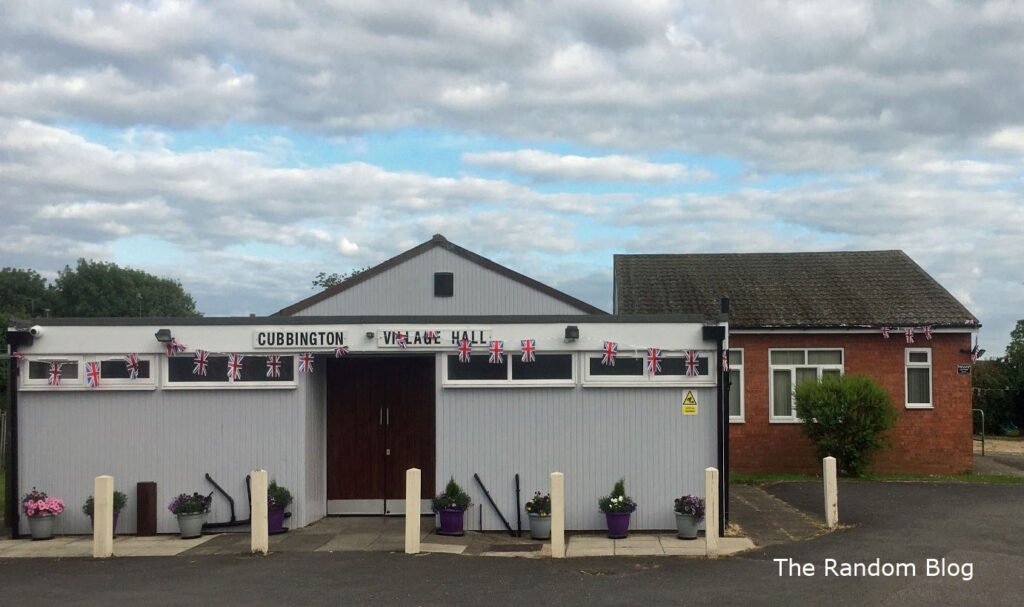
Carnegie Trust
The village halls story starts with Scottish-born Andrew Carnegie (1835-1919). He was an American industrialist who amassed a fortune in the steel industry. In 1901 he sold his steel empire and devoted the rest of his life to philanthropy. Carnegie used his fortune to initiate the creation of charitable foundations in the USA, the UK and Europe, supporting the advancement of education, science, culture and the arts.
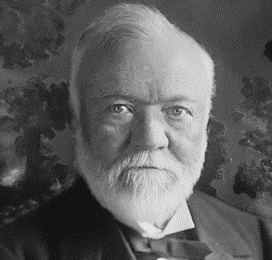
In the mid 1920’s the UK Carnegie Trust together with the Government Development Commission established a village hall grant & loan scheme. The scheme was operated on their behalf by the newly set up National Council for Social Service (NCSS) – now the National Council for Voluntary Organisations (NCVO). It was the Carnegie Trusts “Village Hall Experiment” that we have to thank for the explosion of village halls that started during the 1930’s and carried on into the post second world war years.
The Carnegie Trust funds brought together village representatives from diverse organisations and interests in community led projects to deliver social centres to be held in trust for everyone in their community to use.
In circa 1936, local rural councils (now know as district councils) were engaged to help administer the Carnegie Trusts village hall scheme via the NCSS. The Warwick rural council advertised the scheme in local papers and village committees all over Warwickshire started to make applications under the scheme.
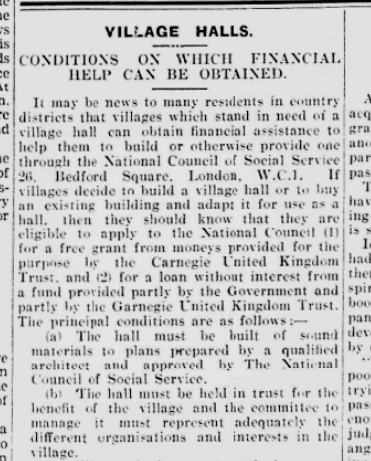
By 1938, events in Europe were looming on the horizon and the Second World War put on hold numerous village hall schemes up and down the country.
Cubbington Joint Defence Services Committee
Fast forward to 1944 and the Cubbington “Joint Defence Services Committee” held a meeting with representatives from First Aid, the Fire service, the Home Guard and the Warders Association in attendance. It’s not known what prompted the discussion, but a new resolution was passed to start fundraising for a “Playing field and Social Centre ”. The committee set about the task of raising money with enthusiasm in anticipation of gaining a grant from the NCSS to build a new village hall after the war ended.
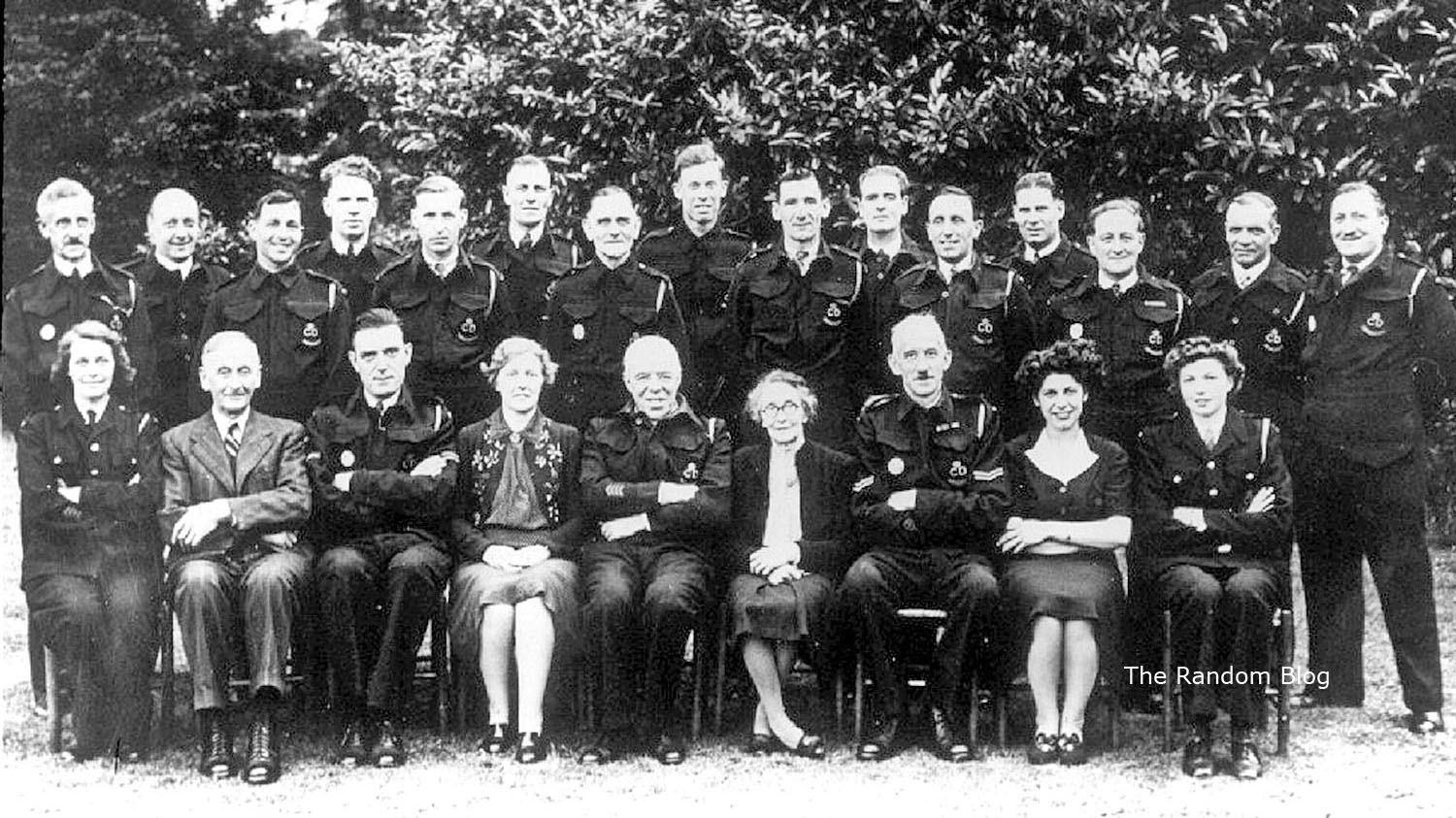
In the first year the fund had raised £519 10s and 7d – an impressive £18,000.00 in today’s money.
The following snippet provides a fascinating list of gifts donated as prizes for the Christmas 1944 fundraising appeal. Clearly war time meat rationing was not an issue for Cubbington with a pig, cockerels and a goose among the locally donated prizes!
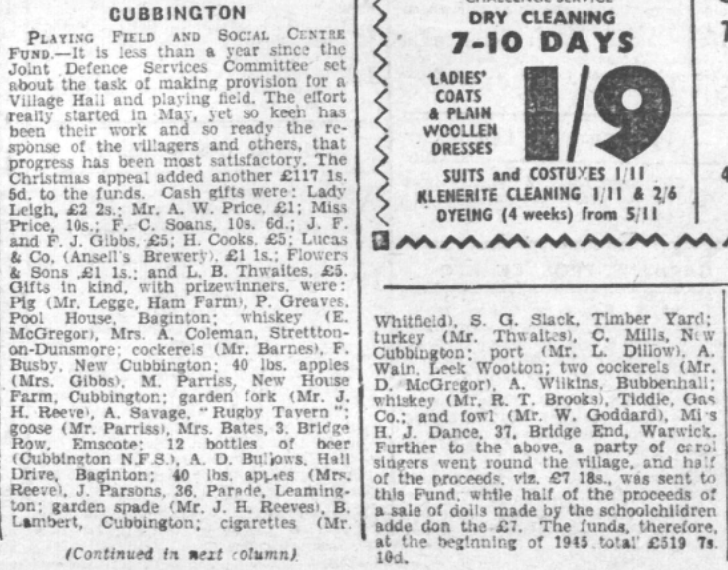
The post war struggle for Cubbington Village Hall
After the war the NCSS village hall grant scheme remained stalled because post war building work was curtailed by the Government imposing building licence restrictions due to the shortage of materials. The NCSS decided to adapt the scheme to enable villages to apply for a “temporary village hall”. This was an ingenious way of using up war surplus “new-fangled” prefabricated buildings such as Army huts and helped to ensure that some of the village hall schemes held up by the war could be progressed.
In early 1947 the Cubbington committee reported the Warwick rural council had offered a site and the committee were planning to inspect its suitability for its grand village hall plan. Little did the committee know in 1947 that agreement on the purchase of this site was going to drag on for another 4 years!
By 1948, the Carnegie Trust considered their “village hall experiment” a success and handed the scheme over to the Ministry of Education who would take it forward & provide funding under the Physical Training & Recreation Act 1937. This change meant new hoops to jump through before Cubbington could proceed.
In the summer of 1948, the Cubbington committee reported high hopes of concluding the purchase of the site for the village hall and duly snapped up the purchase of army surplus furniture in anticipation of getting a village hall building approved.
Alas, the land deal continued to drag on, and the land scheme proposed by the Warwick rural council proved too costly for the Ministry of Education to accept. A compromise was reached with the Ministry of Education for Cubbington to lease the site from Warwick rural council for £30 per year instead of purchasing it.
At the end of 1949 after 5 long years, Cubbington finally seemed to have their ducks in a row with an approved architect’s village hall plan drawn up, land to put the building on and sufficient funding in place to finally deliver the social centre of the committee’s dreams.
Unfortunately for Cubbington it was a case of so near yet so far! The Ministry of Education had run out of money and temporarily halted all new village hall scheme approvals.
Warwick rural council went into bat on Cubbington committee’s behalf and a deal was struck with the NCSS to proceed with the hire of a “temporary village hall” building instead.
In April 1950, the land was finally leased to Cubbington parish council and a trust deed was drawn up and signed with the 26 named original members of the committee. The NCSS assisted village committees in this legal aspect by providing a “model trust deed” which most rural councils and village hall committees used.

The UK Carnegie trusts vision of community spaces run by representatives from within the community was certainly embraced in Cubbington – the trust deed allowed for up to 21 local associations to nominate one representative each to serve on the management committee as trustees.
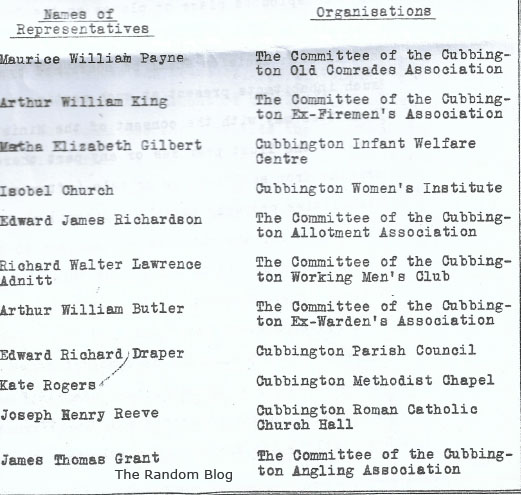
Cubbington Village Hall opens in 1951
On Saturday 31st March 1951 the Cubbington “temporary village hall” was finally opened with great pride and an evening concert of local talent played to a full house.

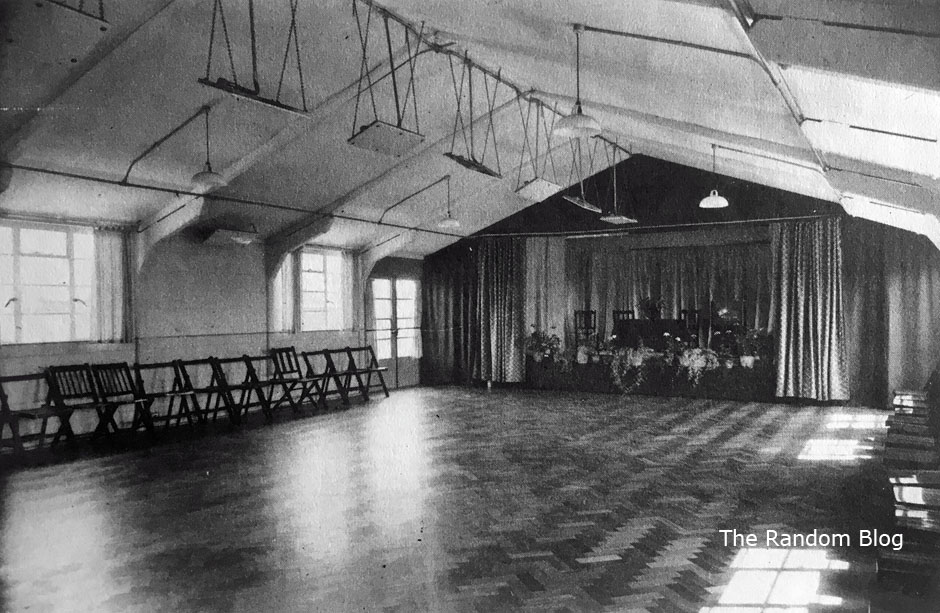
On 13th April 1951 the halls first dance was held and a few days later the village children were able to watch “children’s hour” on the television donated by (Basil) Thwaites to the Village Hall Trust Committee. In its first year, over 70 events were held with dances, whist drives, wedding receptions and other parties proving popular in the new village hall.

Village Hall Trust Committee
In 1952 the Village Hall Trust Committee elected new voluntary members who became responsible for the day to day running of the village hall and the raising of the funds to develop a replacement permanent scheme.
£400 (around £10,000 today) from the Village Hall Trust Committee’s fundraising efforts was donated to the Cubbington parish council in the same year towards the purchase of a new playing field.
In a story twist, Joseph Reeve who had led the efforts of the village hall committee since 1944, resigned in 1953 as chairman of the parish council in protest at the council’s decision to proceed with the purchase of a new playing field and the removal of a number of trees surrounding the field.
In 1954 the complete vision of a “playing field and social centre” was finally realised for Cubbington when the new larger playing field and childrens area located behind the village hall was opened with great fanfare and a fete.
It would take another 54 years to provide the facilities for sports teams mooted during the playing field opening speeches – the “Cliff Cleaver” pavilion was opened in 2008 on what is now referred to locally as the Cubbington recreation ground. You can read more about Cliff Cleaver here: https://www.warwickshireworld.com/news/obituaries/tributes-to-proud-cubbingtonian-cliff-cleaver-2266220
In 1959, the village hall site was conveyed to the Cubbington parish council from the Warwick rural council thus ending the original lease established in 1950. By the end of the 1950’s the NCSS had ended post war temporary village hall hires and village hall committees were encouraged to purchase the hired buildings.
In April 1963, 12 years after the temporary Cubbington village hall was opened, the NCSS were paid the princely sum of £500 (around £9,000.00 in today’s money) for the prefab on behalf of Cubbington which terminated the hire agreement that had been in force since 1951.
The village hall was made an official charity the same year and the Village Hall Trust Committee wasted no time in implementing improvements spending £5,000 (around £88 thousand in today’s money) in 1964 adding toilets, a kitchen and a committee room. It’s not clear how the money was raised but it was a mix of fundraising and grants from the local authority obtained to enable the village hall new kitchen to become the local centre for “meals on wheels” provided by the women’s voluntary service.
It had taken 20 long years through a turbulent and much changed post war Britain to finally fulfil the vision of a permanent village hall and playing field for the people of Cubbington.
The Village Hall Trust Committee made up of volunteer representatives from local organisations remained the custodians of the day to day management of the building, continuing to raise funds for its upkeep through events and grants obtained via the parish & district councils. Over the decades the original “temporary prefab” erected on the site has become hidden behind the various additions and upgrades to the building.
Whats Next for Cubbington Village Hall?
In 2021, Cubbington village hall had its 70th Platinum Anniversary (a year ahead of the Queen!) and the local community now seem to have reached a crossroads on the best way to manage and maintain the building. It is an issue many other similar aged village halls are also facing with limited funding available.
Village halls sometimes appear to be out of step with today’s changing village demographics and modern lifestyles but they are intertwined with the collective community history. They continue to be in demand as much loved and highly valued multi-functional community hubs despite the loss of other aspects of village life such as pubs, corner shops and post offices.